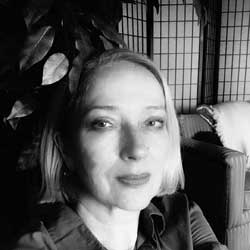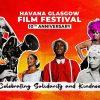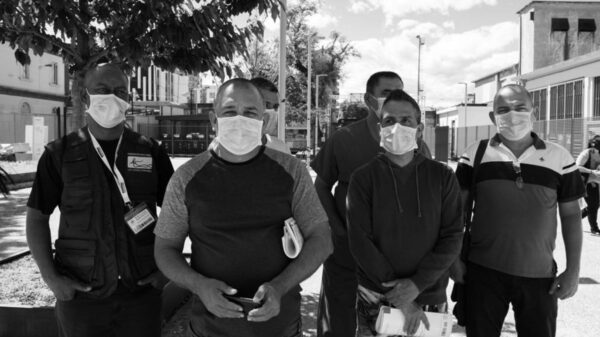Fabrizio Sansoni is a photographer based in Rome, Italy. His most recent exhibition is EROI DEL SILENZIO – a series of stunning black and white images documenting the work of the Henry Reeve Medical Brigades in the city of Turin, Italy.
The Henry Reeve Medical Brigade assisted the Italian doctors when the COVID pandemic was at its height in that nation. Their humanitarian work took place in the field hospital at the OCR-Torino, once a lively cultural center but converted into a hospital, during that time.
This interview took place during the COVID-19 pandemic that holds the world in its grip. I spoke with him a few weeks ago via Zoom while he was working in Rome. It was like the conversation shared between old friends although we’ve never met.
Hernández: How are you?
Fabrizio Sansoni:
I’m fine. Really hot here in Rome. I’m working. Actually, it’s difficult to show you now, but it’s young guys that have a university magazine in Italy. Now, they’ve occupied a building. They are renovating the building to convert into their office, the office of the magazine, like a cultural center.
Hernández: So you’re photographing it?
Yeah, I’m documenting all of these really young guys between the ages of 16 and 25. And they are doing a great job and it’s really, really nice.
Hernández: You said they’re occupying. Do you mean renting or occupying?
Fabrizio:
Oh no, no. It’s actually occupying. It’s an old building that was completely abandoned. Since when I don’t know. It’s an old government building. Actually, it’s this building you see.
(Fabrizio turned his laptop around to show the building surrounding him on the Zoom screen).
Hernandez: I loved your work EROI DEL SILENZIO. I think it’s great because as you know, the US continues to attack Cuba on their medical internationalism in spite of the fact that they’ve provided a lot of medical assistance across the globe during the pandemic. So I think it’s good what you’ve created. The evidence is now in black and white. It’s there. And then there’s a documentary film by Luis Ernesto Doñas, about to be released. You can’t crush that. So, yeah, it’s great.
Your first visit to Havana took place in November of 2019 by invitation of the Cuban Ministry of Culture for events connected to the 500th anniversary of the City. Did your first impressions and experiences of Havana influence your work in the EROI DEL SILENZIO project?
Fabrizio:
This was my first trip to Cuba. I was invited by the government of Cuba, the Ministry, and it was my first time. They organized this international news (classic music festival) under the Artistic Direction of Marcos Madrigal. The festival is called the Habana Clásica. They invited me as a photographer and I stayed almost two months because after the festival there was the first Italian and Cuban production of an opera in the Gran Teatro de la Habana. The opera was La fille du régiment by the composer, Gaetano Doninzetti.
This was the first time that Cuba cooperated with an opera production with the Donizetti Opera Festival of Bergamo. You know, the city that had the most COVID. So they cooperated with this festival, with the city of Bergamo and the Gran Teatro de la Habana. And that’s it. That’s the history of my first trip to Cuba.
Hernández: Did your experience in Havana influence your work EROI DEL SILENZIO?
Fabrizio:
Well, not really, of course, it was the Cuban people and me. Every time I talk about Cuba, the hairs on my skin stand up. I don’t know how to say in English.
Hernandez: How did you become involved in this project— commissioned by the Embassy of Cuba in Italy— to document the work of the Cuban doctors in Turin?
Fabrizio:
So I was called for this work by Ernesto Doñas and the Cuban Ambassador to Italy, Jose Carlos Rodriguez. Ernesto was the director of the Opera. He was asked by the ambassador to work on a short documentary. He asked me to come with him. So I took my camera and was really, really happy to give my support, my camera for that project.
I was happy to go there because I could help in a little way to document the great work, the great humanity, of the Cuban people. To take photos to let the other people know because they talk about Cuba in Turin and Crema, the two cities where Cuban medics were, but they don’t talk enough about it. You know, it was hard work. The doctors came here just to help without anything else. The opposition to the Cuban government said that Italy gave a lot of money to the Cuban medics. It’s not true. They did it just because they are doctors. They have to help others.
Hernández: So the Cuban doctors came to Italy without compensation for their work?
Fabrizio:
Yeah, this is what I know. Even if the doctors were compensated, I don’t see anything wrong with that. But I understand, it was without compensation.
Hernández: Their food and board, of course, was paid?
Fabrizio:
Yes, of course.
Hernández: What did you want to capture and portray in your images? What did your photographer’s eye see when you first entered the hospital and began to work on the project. What were your first impressions while capturing those images? Did you have a goal in mind?
Fabrizio:
The goal was, as I mentioned before, to spread the work of Cuban people, you know, the work they were doing and the passion with which they did it. The first impression was amazing because it was in the old, train repair workshop. It was really big. It is an industrial complex constructed in the late 19th century.
Hernández: Are you talking about the OGR Torino building?
Fabrizio:
Yes, I’m talking about that. It’s where they used to put trains for repairing in the 19th century. In the last ten years, it is where they were doing expositions, museums, discos, where they were doing a lot of cultural activities.
When I entered the first time it was amazing. The silence of this place (the building). We are talking about 1,000 square meters in size. It’s three or four buildings. But one of these buildings was converted into the field hospital. If you can imagine that just before COVID, these buildings were for nightlife, full of people, full of life, and you enter there and you realize the silence and maybe this inspired me for the title of my work, but it’s amazing, the silence. Even when you have some people near you talking, it’s so big, this building, it’s like nobody’s talking, you know.
Hernández: Did you see the patients and the doctors?
Fabrizio:
I saw only the doctors, the patients I never wanted to, or at the beginning, I couldn’t. But if that’s safe, I ask again and again, maybe I could enter. I don’t know. I didn’t feel good, but that was not my objective, you know. I wanted to give a vision of this place and this silence everywhere. So I never went to the Red Zone. I just stopped before entering.
Hernández: When you worked in the hospital were there rules you had to follow?
Fabrizio:
Yes, of course, like every place, but just ten times more. Let’s say every time you enter, they took your temperature, you wore a mask always. Always washing your hands every five minutes. Everybody talking at a safe distance you know, like normal but more controlled.
Hernández: Did you get to know any of the doctors, did you talk to them? How were they feeling about their work?
Fabrizio:
Yes, of course I did. I almost talked to every doctor for sure and Dr. Julio Guerra the head of the Henry Reeve Brigade in Turin. They were very happy to be there, very happy to help like every doctor in the world should be, as they have taken the Hippocratic Oath. There were doctors who were missing their families because they had been away from home for a long time because they had been somewhere else in the world helping with Ebola or something else.
For sure, I can say they were not treated like some people say, like slaves. Those people who say that just don’t know what they are talking about. Those people that say that are just going against the people, full of humanity as the Cubans are.
Hernández: When one arrives at events, we have a preconceived notion of what’s going to happen. Did you hold a preconceived notion that evolved over time once you began working with the Cuban doctors? Tell us about the experience of photographing the doctors as they worked.
Fabrizio:
No, actually, I didn’t. I couldn’t even imagine what it would be like. Like most of the world, to lockdown in the house. The news, always the same videos, and everybody’s scared that if we go out of the house, we are going to die. You know, that period everybody experienced. I don’t know. I was not expecting anything, so. No, not really. I was curious, but I didn’t have a preconception.
Hernández: What was it like photographing the doctors?
Fabrizio:
The amazing thing, because Cuban doctors have a lot of experience, you know, from Ebola, from cholera, from everywhere. So when they came in Italy, they were really well prepared. In Italy we have really high number of hospitals, doctors, but we were not really prepared because in Italy we’ve never had a pandemic.
So when the Cubans came here, they explained something that the Italian medical team knew because there is a protocol. You know, everybody knows what to do. But if you’ve never done it before, you forget to do something really obvious. For example, they put up some mirrors because when you change before going in the Red Zone, you have to look at yourself, you know. To check.
So this is was a really simple thing, but really important, you know, it’s like obvious you have to get in front of a mirror when you go to the Red Zone. For example, the Cuban doctors said the first thing to buy here, is mirrors. Mirrors to look at yourself (as you dress) when you’re putting the mask, the gloves and all the things needed to make sure nothing’s exposed.
Hernández: So the Italians installed mirrors?
Fabrizio:
Yes. This sounds so simple but was one of the first things when you have a protocol. When you have a protocol, everything, is quite obvious. You have to wash your hands every time you touch something or put a mask in front of the patient, obvious things, you know.
But the Cubans, they had the experience and did not have to go and read the protocol. We were not prepared. Some obvious things we didn’t do. The Cuban doctors shared a lot of experience with the other doctors and that was really amazing. And they really work together like one team has to be.
Hernández: You worked with Milena Fiore and the Cuban filmmaker, Ernesto Doñas. How did you work together as a team at the site of the field hospital?
Fabrizio:
We worked really well as a team, so everyone knew what to do. When you have two or three people, maybe you have the same subject, but we give three different views. It was really nice to work with them. And I known Ernesto for some years since we worked together at the Rome Opéra where he is a director and I’m a photographer. I didn’t know Milena. I met her in Turin. I helped him and Milena with cameras. I was filming also with Milena and Ernesto. We were three cameras. It was really nice, a really good, strong team.
Hernández: Will your photographs from EROI del Silencio have a place in the upcoming documentary film by Ernesto Doñas?
Fabrizio:
I don’t know if he filmed me photographing the doctors, but I don’t know if he’s going to use my photos. I don’t think so. Because for me also, it’s would be …. Tu parles francaise?
Hernández: Un petit peu.
Fabrizio:
Well, comme un mélange.
Hernández: Un mélange? A mix?
Fabrizio:
Oui, a mix of two different things. Of course, it’s the same subject, but photography and video, it’s quite different. So I don’t think if he’s going to put my photos in the documentary. He didn’t ask me yet. Maybe he will.
Hernández: Thank you Fabrizio for giving me this interview. It was nice to meet you. I hope to see you in Cuba next year, maybe, who knows?
Fabrizio:
I hope so. Sometimes I think this is like the end of the world slowly happening. I know. It feels like the dinosaur age is coming. But I want to go back to Cuba anyway, maybe in six months. When they open the flights. I’m going to Cuba. OK, it was so nice to meet you and I thank you. Thank you. Bye. A big kiss from Rome.

T.K. Hernández is co-founder and editor at Cuba Business Report. Her work has been published in various online news media publications. Hernández has supported fundraising for Cuba’s last two hurricane disaster relief campaigns and is a member of the Canadian Network on Cuba. She is also a member of The Writers Union of Canada, and ACES International Alliance of Editors. Ms. Hernández is the author of three books, most recently, “The Cuba Interviews: Conversations on Foreign Investment and Economic Development,” (Palgrave Macmillan, 2023).












